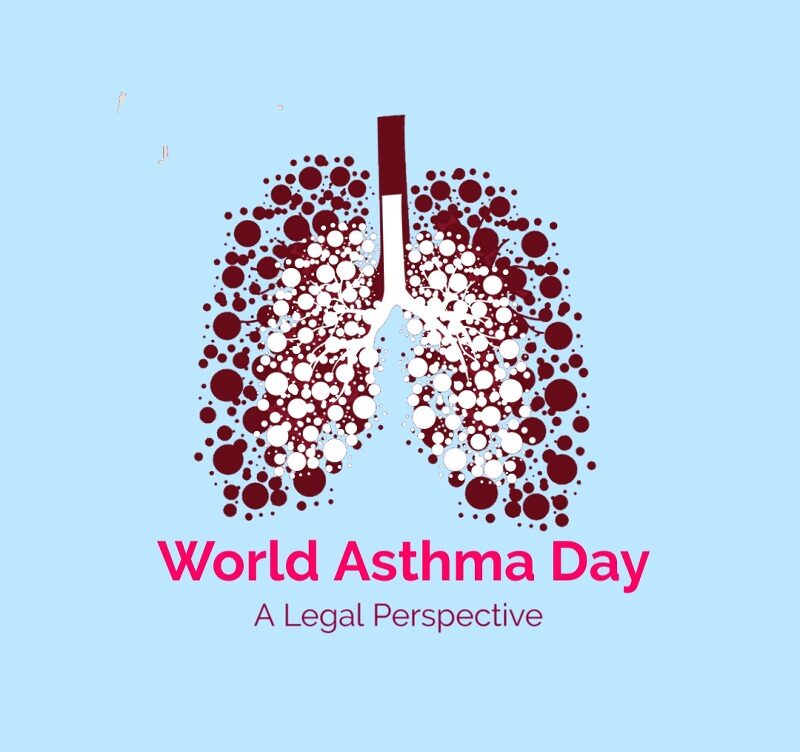What is Asthma ?
Asthma is a condition that affects breathing. It happens when the tubes that carry air into and out of the lungs become swollen and narrow. This makes it hard to breathe in enough air, and it can also cause coughing, wheezing, chest tightness, and shortness of breath.
Asthma can be caused by different things like allergies, exercise, and cold air. But with the right treatment, people with asthma can manage their symptoms and breathe easier. Most people with asthma can still do the things they love, like playing sports or being active, with the help of medication and avoiding triggers.
What is World Asthma Day?
World Asthma Day is an annual event held on the first Tuesday of May. World Asthma Day is an annual event organized by the Global Initiative for Asthma (GINA) to raise awareness about asthma and improve asthma care worldwide. It aims to increase awareness of asthma, improve asthma care worldwide, and advocate for policy change. The event was first held in 1998 and has since been observed on the first Tuesday of May every year.
The first World Asthma Day was observed on May 5, 1998, and since then, it has grown into a global event that is observed in more than 130 countries around the world. Each year, GINA chooses a theme for World Asthma Day, which is used to focus attention on a particular aspect of asthma care.
The theme for World Asthma Day 2023 is “Asthma care for All”. This theme aims to raise awareness and reduce the prevalence of asthma among people.
Legal perspective in addressing asthma
While medical treatments and prevention methods are essential for managing asthma, the legal perspective is also critical in addressing the challenges associated with the disease. Legal frameworks and policies play a vital role in ensuring that people with asthma have access to quality healthcare, medication, and information. The legal perspective also involves advocating for patients’ rights, protecting them from discrimination and ensuring they have a safe environment to live and work. By incorporating legal strategies into asthma management, we can improve the quality of life for people with asthma and reduce the social and economic burden of the disease. In the following sections, we will explore the legal framework, challenges, and strategies related to asthma management and provide examples of successful legal interventions.
Relevant international laws and agreements
- The World Health Organization (WHO) Framework Convention on Tobacco Control: This treaty was established in 2005 to reduce tobacco consumption and exposure to tobacco smoke, which is a major trigger for asthma. The treaty includes provisions for tobacco advertising, promotion and sponsorship, as well as measures to protect people from exposure to tobacco smoke.
- The Montreal Protocol on Substances that Deplete the Ozone Layer: This treaty was established in 1987 to phase out the production and consumption of ozone-depleting substances, which are chemicals that can contribute to air pollution and exacerbate asthma. By reducing the production of these substances, the Montreal Protocol has helped to improve air quality and reduce the incidence of asthma.
- The United Nations Sustainable Development Goals: Goal 3 of the Sustainable Development Goals (SDGs) aims to ensure healthy lives and promote well-being for all at all ages, including the prevention and treatment of non-communicable diseases such as asthma. Goal 7 of the SDGs aims to ensure access to affordable, reliable, sustainable, and modern energy for all, which can help to reduce air pollution and improve asthma management.
- The United Nations Convention on the Rights of Persons with Disabilities: This treaty recognizes the right of persons with disabilities, including those with asthma, to the enjoyment of the highest attainable standard of health without discrimination. The treaty includes provisions for access to healthcare, rehabilitation, and support services.
- The International Union Against Tuberculosis and Lung Disease (The Union): The Union is an organization dedicated to reducing the burden of tuberculosis and lung disease worldwide. The Union works to improve asthma care and control through research, advocacy, and policy development.
- The Global Asthma Network (GAN): GAN is a collaboration of individuals and organizations dedicated to reducing the burden of asthma worldwide. GAN aims to increase awareness of asthma and improve asthma management through research, advocacy, and education.
Domestic Laws and policies related to Asthma (India)
- The National Asthma Control Programme (NACP): The NACP is a national programme aimed at improving the management and control of asthma. It provides for the training of healthcare providers on asthma diagnosis and management, and the development of guidelines for asthma care.
- The National Program for Control of Asthma, Bronchitis, and Chronic Obstructive Pulmonary Disease (NPCABC): This program was launched by the Government of India in 2010 to improve the prevention, diagnosis, and management of asthma, bronchitis, and chronic obstructive pulmonary disease. The program includes measures for improving awareness, training healthcare providers, and strengthening health systems.
- The Air (Prevention and Control of Pollution) Act, 1981: This act aims to prevent and control air pollution, which is a major trigger for asthma. The act provides for the regulation of emissions from industries and vehicles, as well as measures to control indoor air pollution.
- The Clinical Establishments (Registration and Regulation) Act, 2010: This act regulates the registration and operation of clinical establishments, including hospitals and clinics that provide treatment for asthma. The act also provides for quality standards and regulation of healthcare services to ensure the safety and effectiveness of treatment.
- The Drug Price Control Order, 2013: This order regulates the prices of essential drugs, including medications used in the treatment of asthma. The order ensures that these drugs are affordable and accessible to all, especially for those who may not be able to afford them otherwise.
- The National List of Essential Medicines (NLEM): The NLEM is a list of essential medicines that are considered necessary for the treatment of common health conditions. It includes several medications used in the treatment of asthma, such as bronchodilators and corticosteroids. The list ensures that these medications are available and affordable for those who need them.
- The Ayushman Bharat – Pradhan Mantri Jan Arogya Yojana (AB-PMJAY): AB-PMJAY is a national health protection scheme that provides free and cashless access to healthcare services, including treatment for asthma, to eligible beneficiaries. The scheme aims to improve access to quality healthcare services and reduce the financial burden of healthcare expenses on individuals and families.
- National Health Policy: The National Health Policy of India recognizes asthma as a major public health problem and includes provisions for improving the prevention, diagnosis, and management of asthma.
- The Drugs and Cosmetics Act, 1940: This act regulates the manufacture, sale, and distribution of drugs, including medications for asthma management. The act also provides for quality control and regulation of drugs to ensure their safety and effectiveness.
Successful legal interventions in asthma management
- Banned the use of diesel vehicles older than 10 years in Delhi: In India, the National Green Tribunal (NGT) has been instrumental in addressing air pollution, which is a major trigger for asthma. In 2015, the NGT banned the use of diesel vehicles older than 10 years in Delhi, which is one of the most polluted cities in the world. The NGT has also directed industries to comply with pollution control norms, and has taken action against crop burning, which is a major contributor to air pollution in North India. These legal interventions have led to improved air quality and contributed to better asthma management.
- The ban on pet coke and furnace oil: In 2017, the Supreme Court of India banned the use of pet coke and furnace oil as a fuel in the National Capital Region (NCR) to control air pollution. This decision was crucial in reducing the air pollution levels in the NCR, which had been a major trigger for asthma attacks.
- The Right to Clean Air campaign: In 2015, the Centre for Science and Environment launched the Right to Clean Air campaign, which aimed to raise awareness on air pollution and its impacts on public health. The campaign called for the adoption of measures to control air pollution, including the implementation of stricter emission norms for industries and vehicles
- The implementation of the Swachh Bharat Abhiyan: The Swachh Bharat Abhiyan is a national campaign launched in 2014 to promote cleanliness and sanitation in India. The campaign has helped to improve the environment and reduce air pollution in some areas, which has contributed to better asthma management.
- The implementation of the Air Quality Index (AQI): In 2015, the Indian government launched the AQI, which measures the air quality in different cities and provides information on the levels of air pollution. This information is crucial in alerting the public and policymakers on the need for measures to control air pollution
- The Indian government’s decision to include asthma medication in the National List of Essential Medicines: In 2015, the Indian government added asthma medication to the National List of Essential Medicines, which means that these medications are now available at affordable prices across the country. This has helped in improving access to asthma medication, especially for low-income families, and has resulted in better asthma management
- The Asthma Drug Rule: In 2018, the Indian government introduced the Asthma Drug Rule, which requires pharmaceutical companies to label asthma drugs with clear instructions for use and information on potential side effects. This rule has helped to ensure that patients receive the correct medication and use it appropriately, which is essential for effective asthma management.
Challenges to controlling asthma in India
- Poor air quality: Air pollution is a major contributor to asthma in India, and many cities in India have poor air quality. Exposure to air pollution can trigger asthma symptoms and exacerbate the condition.
- Low awareness and education: Many people in India are not aware of the symptoms of asthma or how to manage the condition. This can lead to delays in diagnosis and poor management of the condition.
- Limited access to healthcare: Many people in India do not have access to healthcare facilities that can provide adequate asthma care, especially in rural areas. This can lead to poor management of the condition and exacerbation of symptoms.
- Stigma and discrimination: People with asthma may face stigma and discrimination in India, which can prevent them from seeking treatment or disclosing their condition. This can lead to poor management of the condition and exacerbation of symptoms.
- Cost of medication: While the inclusion of asthma medication in the National List of Essential Medicines has helped to improve access, the cost of medication can still be a barrier to effective asthma management for many people, especially those with low incomes.
- Limited research and data: There is limited research and data on asthma in India, which can make it difficult to develop effective strategies for controlling the condition.
Possible ideas to control asthma
- Mobile health clinics: Mobile health clinics could be used to provide asthma care to people in rural and remote areas where access to healthcare is limited. These clinics could be equipped with telemedicine technology, enabling healthcare professionals to diagnose and treat asthma remotely.
- Air filtration systems: Air filtration systems could be installed in public spaces, such as schools and hospitals, to reduce exposure to air pollution. These systems could be designed to filter out the particulate matter and pollutants that are known to trigger asthma symptoms.
- Asthma education programs: Asthma education programs could be developed to improve awareness and understanding of the condition. These programs could be targeted at schools, workplaces, and other public spaces, and could include information on the symptoms of asthma, how to manage the condition, and how to avoid triggers.
- Green spaces: Increasing the number of green spaces, such as parks and gardens, in urban areas could help to reduce exposure to air pollution and provide a space for exercise, which can help to manage asthma symptoms.
- Telemedicine: Telemedicine technology could be used to provide remote consultations and follow-up care for people with asthma, reducing the need for in-person visits to healthcare facilities.
- Patient-centered care: A patient-centered approach to asthma care could be adopted, which takes into account the individual needs and preferences of people with asthma. This could involve personalized treatment plans, patient education, and support for self-management.
In many countries, people with asthma are protected under disability discrimination laws. This means that employers, educational institutions, and other entities cannot discriminate against individuals with asthma and are required to provide reasonable accommodations to enable them to perform their duties or participate in activities.
It is important to note that legal requirements and protections may vary depending on the country and jurisdiction. If you have specific legal questions or concerns related to asthma, it is advisable to consult with a qualified legal professional in your area.





